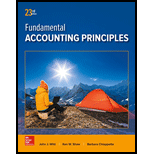
Introduction: Budgeting is very important process in managing future financing affairs of a business entity. Budgeting is refers to better estimations about possible inflows & outflows of funds in the business. In same manner budgeting guidelines are the directions that need to be followed in budgeting process.
To choose:
We have to select out of yes or no for given statements with reference to budgeting guidelines.
1. ……..Employees should have the opportunity to explain differences from budgeted amounts.
2………Budgets should include budgetary slack.
3………Employees impacted by a budget should be consulted when it is prepared.
4………Goals in a budget should be set low so targets can be reached.
5………Budgetary goals should be attainable.
Want to see the full answer?
Check out a sample textbook solution
Chapter 22 Solutions
Fundamental Accounting Principles
- Please provide the correct answer to this financial accounting problem using valid calculations.arrow_forwardCan you solve this financial accounting question with the appropriate financial analysis techniques?arrow_forwardFlow of Production Units Units to be accounted for: Beginning WIP inventory Units started this period Total units to be accounted for Units accounted for. Units completed and transferred out: From beginning inventory Started and completed currently Units in ending WIP inventory Total units accounted for Costs to be accounted for. Costs in beginning WIP inventory Current period costs Total costs to be accounted for Cost per equivalent unit Prior department costs Materials Labor Manufacturing overhead Costs accounted for. Costs assigned to units transferred out: Costs from beginning WIP inventory Cument costs added to completa beginning WIP inventory: Prior department costs Materials Labor Manufacturing overhead Total costs from beginning inventory Current costs of units started and completed Prior department costs Materials Labor Manufacturing overhead Total costs of units started and completed Total costs of units transfered out Costs assigned to ending WIP inventory. Prior department…arrow_forward

 AccountingAccountingISBN:9781337272094Author:WARREN, Carl S., Reeve, James M., Duchac, Jonathan E.Publisher:Cengage Learning,
AccountingAccountingISBN:9781337272094Author:WARREN, Carl S., Reeve, James M., Duchac, Jonathan E.Publisher:Cengage Learning, Accounting Information SystemsAccountingISBN:9781337619202Author:Hall, James A.Publisher:Cengage Learning,
Accounting Information SystemsAccountingISBN:9781337619202Author:Hall, James A.Publisher:Cengage Learning, Horngren's Cost Accounting: A Managerial Emphasis...AccountingISBN:9780134475585Author:Srikant M. Datar, Madhav V. RajanPublisher:PEARSON
Horngren's Cost Accounting: A Managerial Emphasis...AccountingISBN:9780134475585Author:Srikant M. Datar, Madhav V. RajanPublisher:PEARSON Intermediate AccountingAccountingISBN:9781259722660Author:J. David Spiceland, Mark W. Nelson, Wayne M ThomasPublisher:McGraw-Hill Education
Intermediate AccountingAccountingISBN:9781259722660Author:J. David Spiceland, Mark W. Nelson, Wayne M ThomasPublisher:McGraw-Hill Education Financial and Managerial AccountingAccountingISBN:9781259726705Author:John J Wild, Ken W. Shaw, Barbara Chiappetta Fundamental Accounting PrinciplesPublisher:McGraw-Hill Education
Financial and Managerial AccountingAccountingISBN:9781259726705Author:John J Wild, Ken W. Shaw, Barbara Chiappetta Fundamental Accounting PrinciplesPublisher:McGraw-Hill Education





